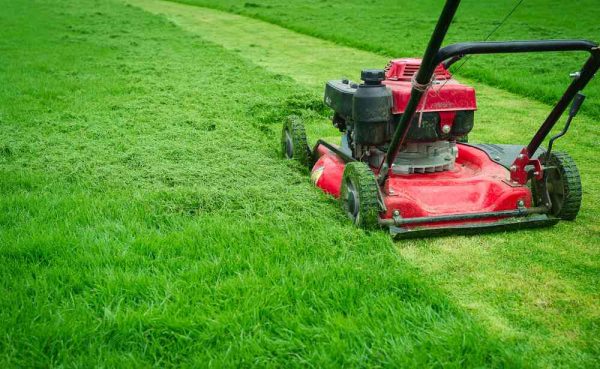Have you ever looked at someone’s lush, green grass and thought to yourself, “I wish my lawn looked like that’? Or maybe you’ve planted your own grass with the best intentions, only to find that it was harder to maintain than you thought?
In order to grow healthy, beautiful grass, you must first understand the fundamentals of lawn maintenance and care. Here at Jim’s Mowing, we have been Australia’s leading lawn experts for years – so today, we’re going to reveal what you need to know to create a bed of grass so beautiful that you’re the envy of everyone in your street.
What you need to know about growing and maintaining a beautiful lawn…
How often should I mow my lawn?
Letting your grass get overgrown and messy doesn’t just look bad, but it can do serious damage to its overall health. This is why sticking to a regular mowing schedule is key to growing a healthy, lush lawn. The ideal frequency will vary depending on the season, rainfall and the amount of sunshine your lawn is getting, so it’s important to keep an eye on your grass to know when it needs a mow.
You can use these seasonal timeframes as a general guide:
- Summer: Once every fortnight.
- Autumn/Winter: Once every two-five weeks.
- Spring: Once every two-four weeks.
What height should my grass be?
The ideal height of your grass will vary depending on its variety, the season and the conditions it’s growing in. When buying your seed or turf, be sure to ask your supplier what the ideal conditions are for its kind.
As a general rule, you shouldn’t cut more than 1/3 of the grass blade off with each mow, as this can strip the grass of its nutrients and stop it from growing. On the other hand, letting your grass grow too long can stop sunshine and water from reaching the bottom layers. This causes the foundation to become dry and dead and can make it the perfect hiding place for insects and rodents. In short, finding that perfect height is essential for a healthy, luscious lawn!
How often should I water my lawn?
Contrary to popular belief, it isn’t always necessary to water your lawn every day in order to keep it in great condition. Throughout the warmer months, giving your lawn a deep watering twice a week is usually sufficient. If you’re experiencing quite a dry summer, you might want to add an additional water in every now and then to stop the grass from drying out.
In the winter, intense watering is often not needed unless it has been quite a dry season. You don’t want to over-water your lawn as this can lead to disease, so you should only water when necessary.
Regardless of the season, paying attention to the look and feel of your lawn is key to ensuring it is getting enough water. If you notice it looking a little dry or too wet, alter your watering routine to suit.
When is the best time to water?
The ideal time to water your lawn is in the early morning or in the evening when the sun isn’t too hot. This ensures that you minimise the amount of water lost through evaporation and treats your lawn to a deep hydration to help it grow.
What type of grass do I have?
In order to care for your lawn in the best way possible, you must first understand which variety of grass you have. Whether you buy your grass as seeds or turf, you should ask the supplier for more information about the variety, the ideal height and its watering needs to ensure it grows into a lush, beautiful lawn. There is also a huge variety of helpful information online that can help you understand more about your variety, so be sure to use the power of Google to your advantage!
When should I plant new grass?
If you’re thinking about planting seeds for new grass, it’s important to do it at the right time of year. In Australia, Spring time is usually considered optimal grass-growing season as the weather is neither too hot nor too cold. This give your grass seeds enough time to grow without being interrupted by harsh weather patterns, such as the dry Summer heat or an abundance of rain in Winter.
Is fertiliser important?
Fertiliser is super important to achieving a healthy, beautiful lawn. The reason for this is simple; just like us humans, grass requires a delicate balance of nutrients in order to thrive. The right fertiliser will contain the ideal amount of these nutrients for your particular grass variety, providing a pick-me-up when your lawn might be lacking what it needs to grow.
When is the best time to fertilise?
While fertiliser can be used any time of year as needed, it is particularly great to use at the end of Autumn and the start of Spring. As the inclement weather experienced during the Winter months can be harsh on your lawn, treating it to some quality fertiliser either side of this season can help it to flourish and replenish the nutrients it may have lost along the way.
In addition to this, you can use fertiliser as a ‘pick-me-up’ for your grass when it’s looking less healthy than you like. However, it’s important to rule out any other potential issues such as pests or lawn disease first, as fertiliser won’t fix these issues long-term.
Should I use mulch?
Mulch is another great way to provide extra nutrients to your lawn. The best part? It’s easy and very affordable! In fact, you can simply use your own lawn clippings as mulch, as they contain a host of great organic nutrients that can really benefit your grass.
Most modern lawn mowers can be modified to include a mulching component, which essentially helps to cut down your grass clippings and redistribute them onto your lawn. They are then re-absorbed by your soil, providing your grass with a range of amazing nutrients that will help it grow.
How do I control weeds?
No one wants their beautiful garden littered with weeds. Fortunately, however, it is possible to ward off these unruly visitors with the right approach. Here are a few simple tips to help you keep the weeds away:
- Mulching your garden regularly will deprive weeds of the light they need to thrive. Mulch can also be a great home for tiny, helpful insects who love to feast on weed seeds before they get the chance to grow.
- Remove weeds from the root to give them as little chance of growing back as possible! It’s best to do this using a tool that allows you to twist the weeds up and out of the ground, such as a sharp gardening tool or even an old fork!
- Try not to water the weeds! Like any other plant, weeds require water and sunlight to grow. By dodging them when you’re doing the watering rounds, you will be depriving them of a vital nutrient.
How do I spot lawn diseases?
Did you know that your lawn is susceptible to disease just like any other plant? There are various common lawn diseases in Australia, but if you spot them early enough you can treat the problems before it wreaks too much havoc on your grass.
Here are a few common lawn diseases and their symptoms:
- Athracnose – Patches of reddish-brown and yellow grass.
- Fusarium Patch – Patches of warm brown grass.
- Brown Patch – Brown, circular patches of grass.
- Fairy Ring – Circular patches of dead or wilted grass or mushrooms.
- Powdery Mildew – Grass covered with a white powder.
If you notice any of these problems with your lawn – or anything else that seems unusual – speak to a professional who can help you determine the appropriate treatment as soon as possible.
Do I need pest control?
If left untreated, bugs and pests can do serious damage to your lawn over time. Identifying the issue and treating it as quickly as possible is important to minimising any damage.
These common symptoms might indicate that your grass is home to unwanted pests or bugs:
- It’s natural for birds to forage on a healthy lawn – but if they are digging at your grass so often that it becomes a problem, it could be a sign that bugs are lurking underneath. Birds will dig at your lawn to feed on pests, so be sure to investigate the issue further if you find that this becomes an all-too-common occurrence.
- Certain bugs will eat away at the roots of your grass, leaving these patches to slowly die. If you notice that your otherwise healthy lawn starts developing dead patches, this could be a sign of pests underneath.
- Raised mounds of soil can indicate that you have ant nests living on your lawn. Not only can they stop healthy growth, but they can cause nasty bites when you’re trying to relax on your lawn.
Are pesticides dangerous?
Pesticides are designed to exterminate any bugs or pests that might be damaging your lawn. While there are a wide range of options on the market, most are made with chemicals that can be toxic, particularly to children and pets.
If you’re thinking of using pesticides to treat your lawn, be sure to do your research and understand how long you should steer clear of the area to avoid any harmful side effects.
Should I invest in organic lawn care?
Organic lawn care optimises the soil conditions of your lawn to produce healthy, luscious grass. This approach has long been used by professional farmers to improve their crops and is now being used in household gardens as an alternative to chemical pesticides.
Organic lawn care offers various benefits, including:
- A healthier lawn with the right nutrients that allows it to naturally ward off pests and disease.
- A healthier environment, as organic lawn care doesn’t use any toxic chemicals or pesticides that can harm humans or pets or run off into waterways.
- The ability to save time and money by providing your lawn with what it needs to stay healthy. Rather than having to treat your lawn to pesticides and disease control, organic lawn care helps it to stave off these issues on their own.
Do I need to test my soil?
As we mentioned earlier, different varieties of grass require different levels of nutrients to thrive. For this reason, testing your soil is a great way to understand the type of fertiliser or organic lawn care you will need to apply in order to grow a luscious, healthy lawn.
Testing your soil can be done in a number of ways. You can choose to have a professional visit your home to do it, or you can buy an at-home testing kit from a trusted gardening or soil store.
We’re here for all your lawn maintenance needs!
Jim’s Mowing has been Australia’s trusted garden and lawn experts for many years. Our wide range of services makes it easier than ever to grow and maintain a beautiful, healthy lawn.
Get in touch with your local Jim’s Mowing franchise today to enquire about our services!


Recent Comments